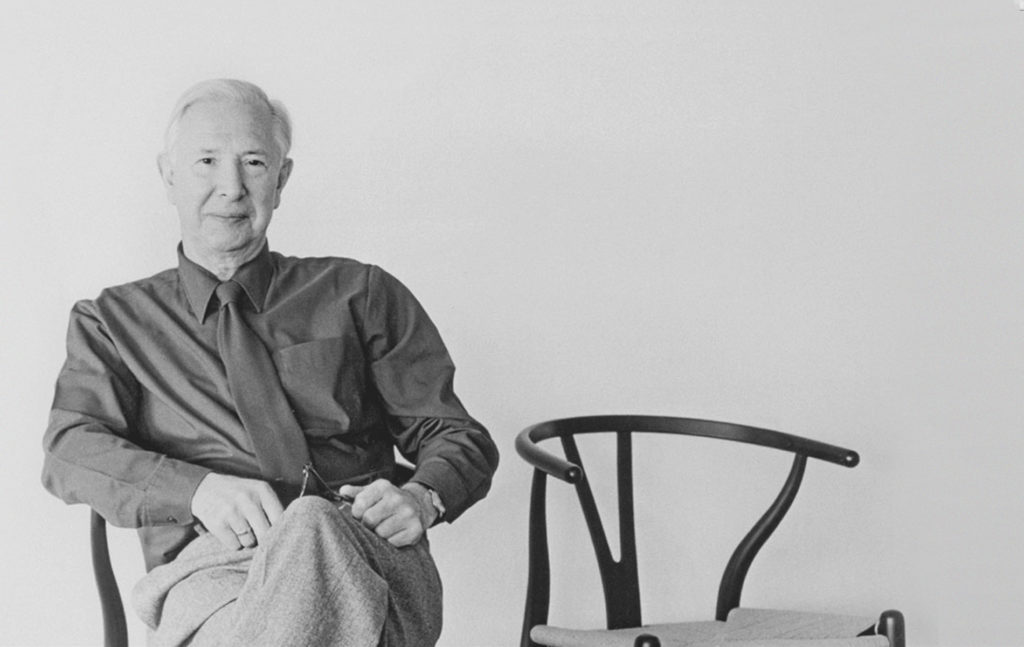Also known as the CH24 Chair, the Wishbone Chair is one of the world’s most instantly recognisable chairs. Created by Danish designer Hans J. Wegner, the versatile chair can be found in dining rooms, kitchens and living spaces across the globe.
Read on to find out everything there is to know about this classic chair and the designer behind it.
Behind the design
Hans J. Wegner first designed the Wishbone Chair in 1949 for renowned manufacturer Carl Hansen & Søn. Part of a series of lightweight chairs that Wegner designed for the brand, the Wishbone Chair has been exclusively crafted at its Danish workshop ever since.
Whilst designing the chair’s distinctive silhouette, Wegner found inspiration in the curved wooden backs of traditional Ming chairs. Having spotted them in a portrait of Danish merchants, Wegner reimagined the design for a contemporary audience.
The final Wishbone Chair boasts a modern steam-bent back that offers a truly comfortable sit. This was one of Wegner’s overarching goals and to achieve it he combined the back and armrest into a single piece.
The chair’s most characterful feature is often considered the Y-shaped back that it takes its name from. But the addition isn’t just a design feature. The wishbone-shaped back provides additional support to the armrest, as well as the user.
Hans J. Wegner
“A chair is to have no backside. It should be beautiful from all sides and angles.”
How it’s made
Each Wishbone Chair that leaves Carl Hansen & Søn’s studio is meticulously produced by master craftspeople.
Over 100 individual steps are involved in creating the chairs, the majority of which are carried out by hand. One of the most impressive examples is the hand-woven seat that takes even the most skilled artisan over an hour to weave. This is because approximately 120 metres of paper cord are used to create the seat to ensure longevity and robustness.
About the designer
Hans J. Wegner is widely considered a driving force behind the Danish Modern design movement. His furniture embodies this golden age of design with clean lines, natural materials and pared-back silhouettes taking centre stage.
His career in design began at the age of 14 as an apprentice for Danish master cabinetmaker H. F. Stahlberg. Later studies at Copenhagen’s School of Arts and Crafts cemented his drive and Wegner soon set out as a furniture designer. Wegner went on to design over 500 chairs throughout his career, an impressive feat that earned him the moniker ‘Master of the Chair’.
“The chair does not exist. The good chair is a task one is never completely done with.”
Hans J. Wegner
Wegner possessed a deep understanding of wood and its characteristics thanks to his training as a cabinetmaker. This led to a respect for natural materials that helped shape his characteristic organic and minimalist aesthetic.
Throughout his life Wegner was celebrated with countless prestigious awards in recognition of his contribution to design. These include the 1951 Grand Prix at the Milan Triennale, the 8th International Design Award and Sweden’s Prince Eugen Medal in 1961. He even received an honorary Doctorate from the Royal College of Art in 1997.
Today his furniture designs can be found in some of the world’s most famous museums. These include New York’s MoMA, the Designmuseum Danmark in Copenhagen and Munich’s Die Neue Sammlung.

